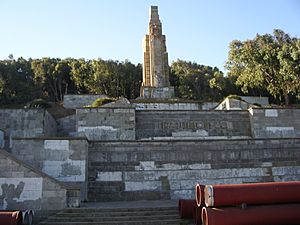Monumento del Llano Amarillo facts for kids
The Monumento del Llano Amarillo is a tall monument located in Ceuta, a Spanish city in North Africa. It stands at the base of Mount Hacho. This monument is fifteen meters (about 49 feet) tall. It was moved to Ceuta from Morocco in 1962. It is one of the few sculptures left that reminds people of Spain's period of nationalism after the Spanish Civil War.
Contents
History of the Monument
This monument remembers an important "oath before the battle." This oath was made by generals, led by General Yagüe, on July 12, 1936. This event was part of the plan that started the Spanish Civil War. The monument was designed by the sculptor Bonifacio López Torvizco. The architect who helped build it was Francisco Martínez Hernanz.
Building the Monument
The monument was first shown to the public on July 13, 1940. It was built in a place called Llano Amarillo, near Issaguen, in what was then the Spanish Protectorate of Morocco. Today, this area is part of independent Morocco. The monument became a symbol of the defeat of the republican forces in the war. The main part of the monument is a tall stone pillar, fifteen meters high, with shapes that look like wings. General Yagüe led his soldiers across the Straits of Gibraltar from Ceuta. He then met with other soldiers near Seville. General Yagüe was a key leader in the war, but his actions were very controversial.
Damage and Moving the Monument
At one point, a group of five people damaged the monument. They were supported by Catalan banker Josep Andreu Abelló, who was living in exile. The group used paint to write "Amnesty and Freedom" on the monument. This message was about Spanish political prisoners at that time.
In 1962, Morocco became an independent country. Because of this, the monument was carefully taken apart, stone by stone, in Morocco. Then, it was rebuilt in its current spot in Ceuta.
The Monument Today
The Monumento del Llano Amarillo is one of the few monuments in Spain that remembers the time when General Franco ruled the country. Even though it is still a debated topic, there have been no recent attacks on the monument.
See also
 In Spanish: Monumento del Llano Amarillo para niños
In Spanish: Monumento del Llano Amarillo para niños



